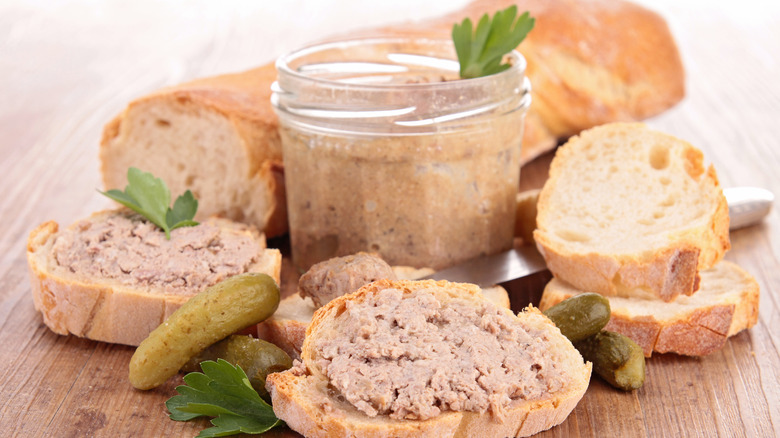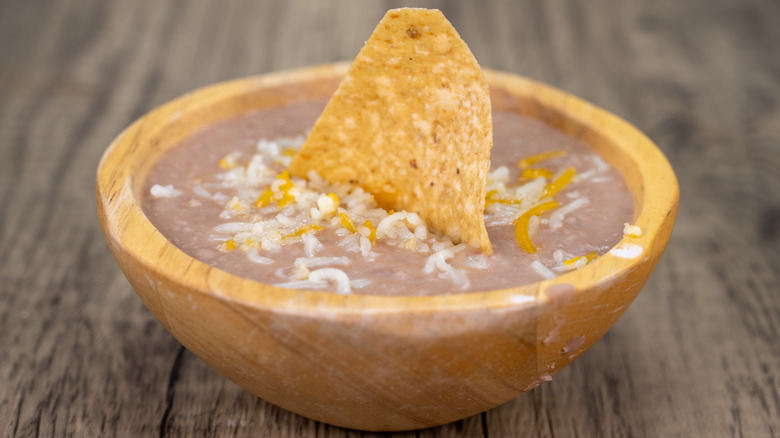The Top 7 Store-Bought Dips You Should Splurge On And 7 To Avoid
No snacking session is complete without a dip to bring that rich flavor and crucial textural contrast to your chips or crackers. Dips not only add an element of customization to a dish but also an element of community. They are meant to be experimented with and shared, making them a great dish for entertaining. But are they meant to be bought at a store or made at home?
That's the key topic of discussion at hand, and unfortunately, it doesn't have a straightforward answer. Whether you should buy or prepare snack accompaniments depends on several factors, including how hard they are to make, how readily available the ingredients are, and how much time they take to prepare. Based on these parameters, we came up with a list of several dips that are usually worth buying premade and several that are usually worth making at home. Without further ado, let's dip into this discussion.
Buy: foie gras mousse
Buying foie gras mousse premade should be a no-brainer unless you have reliable access to fatty duck liver. There is no substitute for this rare delicacy of an ingredient, so this specialty food is best left to the experts. This also applies to other types of meat pâtés, which are typically just as time-consuming to make even if they aren't made with uncommon organ meats.
If you happen to find a premade serving of foie gras at the store, you could theoretically assemble this dip at home more easily by whipping some cream and seasonings into the premade foie gras. However, foie gras is neither a kitchen staple nor shelf-stable, so it is unlikely that you would have some on hand without planning ahead. Additionally, foie gras mousse must be set in the fridge overnight to achieve that perfect texture.
Unless you are passionately interested in making this dish yourself, it is best to keep foie gras mousse a splurge purchase. Plus, to make it yourself is to deny the very luxury it was designed to evoke.
Avoid: hummus
Hummus is not only one of the most delicious and versatile dips but also one of the easiest to make at home. If you own a food processor, you can make hummus at home that is tastier and cheaper than premade options at the grocery store. Hummus requires only a few key ingredients, most of which are shelf-stable. Our lemon hummus recipe calls for tahini, olive oil, garlic, a lemon, and two cans of chickpeas. And it only takes about five minutes to prepare. This makes it an easy treat to whip up on a moment's notice.
The best part about hummus is that its simple base flavor adapts seamlessly to a myriad of other flavors. You can easily incorporate different herbs, spices, and vegetables into your hummus to experiment with new variations. You can even mix it with the other dips on this list. This makes it a great way to clear the fridge of leftover ingredients from previous meals. So, try making your own hummus next time instead of buying it premade from the store.
Buy: nacho cheese
As simple as nacho cheese may seem, it is a deceptively complicated topping. There are a number of common pitfalls one can make when attempting to concoct DIY nacho cheese, and the result will probably end up pricier than the premade stuff. One of the main issues is that quality nacho cheese requires a specialty ingredient: sodium citrate. This ingredient is crucial to achieving the velvety and emulsified consistency that makes nacho cheese perfect for drizzling. And unless you make nachos every week, it's also something that will eventually collect dust in your pantry.
Granted, there are other methods of making nacho cheese that don't require specialty ingredients, but they are rarely better than the stuff that comes in a jar. Preparing alternative nacho cheese hacks online could be fun on a special occasion, but if you're just looking to entertain a crowd with some snacks, nobody will balk at store-bought cheese sauce.
Avoid: guacamole
Guacamole is a finicky dip, and making it homemade has its challenges. Yet, making guacamole at home is still the superior option despite any complications. That's because homemade guac is cheaper and tastes better. Most avocado enthusiasts have probably already noticed that store-bought guacamole has an unusual taste because of the citric and ascorbic acids used to preserve this dip's bright green color. As nice as it is to see that bright green color even after this dip's sat out for hours, it is not worth the extra cost and worse flavor. Plus, guacamole that has oxidized still tastes just as good, even if it has turned slightly brown.
We get it, though; it's not always possible to make guac at home. The biggest obstacle to doing so is finding ripe avocados when you need them. And since avocados have such a short shelf life, you will want to make and consume your homemade guac on the same day. But if your batch of guac is good enough, there shouldn't be any leftovers, period. As long as you live in an area where avocados are available year-round, this is a dip worth making at home.
Buy: baba ghanoush
Although baba ghanoush is similar to hummus in texture and flavor, it takes significantly longer to make and, therefore, is something you're usually better off buying premade. That's because the irreplaceable base of this delicious dip is roasted eggplant, and it takes about an hour in the oven for this vegetable to get tender enough to blend. To further complicate things, eggplant doesn't have the best seasonal availability in the U.S., so you may be hard-pressed to find some fresh depending on the time of year.
This is not to say that baba ghanoush is impossible to make at home, though. In fact, we have a fairly simple yet delicious recipe worth trying if you have the time. However, this is not a dip you can quickly whip up for a frantic snack session. The convenience of store-bought baba ghanoush is the practical choice for those looking to savor this delectable dip without the kitchen commitment.
Avoid: bean dip
Yes, we just knocked baba ganoush for having to be prepped in the oven before serving. And, yes, bean dip must also be baked in the oven to achieve the ideal consistency. But bean dip is still well worth making at home. The main reason is that the ingredient list is almost entirely shelf-stable and straightforward enough that you probably have everything on hand to make this dish right now. So, sure, there's that 30-minute cook time to consider, but you probably won't also have to factor in a trip to the grocery store.
Bean dip is also cheaper and tastier when made at home. By making this meal from scratch, you can prepare several batches of bean dip for the same price as one container of premade bean dip. And since you're making it yourself, you can fine-tune every detail, from the spice level to the type of bean, ensuring you get exactly what you want from your snacking experience. There may be a time and a place for premade bean dip, but it is not your weeknight snack session.
Buy: French onion dip
Although French onion dip requires relatively few ingredients to assemble, it is quite time-consuming to prepare. That's because it can take up to an hour to properly caramelize onions, and caramelized onions are a non-negotiable ingredient for any French onion dip. Though you'll find a number of kitchen hacks online to accelerate the process, we've tried them all, and nothing matches the rich and sweet flavor of proper caramelization. So it's probably a better use of your time and money to just buy premade French onion dip.
However, that's not to say you should never bother caramelizing onions at home. If you plan ahead by making a big batch of caramelized onions ahead of time, you can cut the preparation of this dip back down to a reasonable five minutes. You should also have no trouble finding new uses for your leftover caramelized onions. They are an excellent topping for pizza, burgers, pasta, and even other spreads like hummus and jam.
Avoid: tzatziki sauce
Tzatziki sauce is a must-have condiment for various Mediterranean dishes ranging from gyros to kebabs to meze platters. And if you already have the kitchen know-how to serve these dishes at home, then you definitely have the ability to make your own tzatziki sauce. The recipe for homemade tzatziki sauce is incredibly simple. It only requires five ingredients: Greek yogurt, cucumbers, dill, garlic, and lemon juice. And while our recipe calls for using a food processor, you can just as easily grate your cucumber for a chunkier tzatziki dip.
Considering the low price of tzatziki's ingredients, you will typically pay more for less when you buy a premade version of this dip at the store. However, buying it premade is still viable when you are short on time or energy. Just don't fool yourself into thinking that a smaller portion is better for a sporadic consumer of Mediterranean food. Tzatziki can be kept in the freezer for up to three months, so there is no problem with saving your leftovers for the next time you're craving a homemade gyro.
Buy: seven-layer dip
Seven-layer dip is a fairly enigmatic piece of Tex-Mex culture, whose origins are largely unknown beyond its debut appearance in a 1981 issue of Family Circle magazine. This recipe was unlikely to be created before the mid-20th century, though, as this dip would be a nightmare to prepare without modern conveniences like refrigerators and microwaves. Without even getting into the ingredients list, it should be apparent from the name alone that seven-layer dip is something you should buy premade 99% of the time. It is excessively personified, and the end result isn't that much better than just preparing a humble bowl of guacamole.
It's hard to say exactly which ingredients you will need to buy if you choose to take on the Herculean task of preparing this dip at home. Rest assured, there are at least seven ingredients in most recipes. But there is absolutely no standardization of what each layer should be, nor what order you should place them in. Looking at seven popular online recipes, none agree upon a standard set of ingredients or a proper order to layer them (via Mel Magazine). If you still feel like trying to make a seven-layer dip at home after reading that, then good luck to you. At our next Super Bowl party, we'll be saving time, money, and mental fortitude by buying a premade seven-layer dip.
Avoid: pesto
Pesto is a contentious topic regarding the debate of store-bought versus homemade. Both sides have their advantages, but the fresh flavor and relative ease of assembly of pesto means that it is often better to make at home. Our simple basil pesto sauce recipe requires only a few ingredients: basil, garlic, pine nuts, olive oil, parmesan cheese, and lemon juice. It can also be made with other herbs like spinach, cilantro, or parsley, depending on what you have on hand. And since fresh herbs make up the base of its flavor profile, you will always get a better flavor from the homemade stuff. And when used as a dip, that flavor difference will be all the more apparent. However, it won't keep for nearly as long as premade pesto in a jar (which is about the same price).
This longer shelf life is the main benefit of premade pesto, as it makes for an easy addition to lazy weeknight meals like pasta, bruschetta, or sandwiches. The preservatives found in jarred pesto make it less flavorful, though, so there is a tradeoff for that convenience. Ultimately, the choice between store-bought and homemade pesto is personal, as both have valid benefits. That said, every cook worth their salt should make this herbaceous spread from scratch at least once.
Buy: aioli
Aioli is a somewhat misunderstood dip. According to many food bloggers, all you need to make aioli is a mix of mayo, garlic, lemon, and Dijon mustard. In reality, a traditional aioli is more involved. If you follow Ting Dalton's traditional aioli recipe, you'll have to incorporate a few more kitchen skills than just tossing ingredients into a food processor. At the very least, you'll need to know how to separate egg yolks and create an emulsification without letting said egg yolks split. While this is far from the most complicated preparation for a dip, it can still be intimidating enough to make buying premade aioli an attractive alternative — at least for more novice chefs.
If you haven't done much emulsification before, you may want to get some practice under your belt before serving a dip like aioli to your house guests. Once you consistently get the right texture without the sauce breaking, you can save some money by making your own aioli at home. But until then, store-bought aioli means less stress and less time in the kitchen.
Avoid: spinach and artichoke dip
Considering that spinach and artichoke dip is one of the easiest condiments to make from this whole list, you should only buy a premade version of this dip if you are feeling supremely lazy. Otherwise, you could make a cheaper and more flavorful version at home with only a few ingredients. Our cold spinach and artichoke dip recipe only requires cream cheese, mozzarella cheese, sour cream, canned artichoke hearts, spinach, and a few minutes of your time. Assuming you use frozen spinach, all of these ingredients keep for quite a while. And since it takes minimal prep to combine them, you can have it ready in an instant.
If you prefer a hot spinach and artichoke dip, you'll also have to factor in the time to bake it in the oven. However, you'll have to do the same thing with a store-bought spinach and artichoke dip, so this isn't a benefit for the premade option. In fact, given the artificial ingredients and inflated price tag, there is no other benefit of going store-bought other than the convenience factor. Homemade spinach and artichoke dip is the way to go.
Buy: tapenade
Tapenade may not be the worst culprit on this list regarding complicated preparation methods or ingredient lists, but it has more specialty ingredients than the average dip. That means home cooks who could go either way on homemade versus store-bought will tend to favor buying this dip premade. An authentic tapenade recipe typically includes ingredients like olives, capers, and anchovy fillets, all of which are less common in U.S. households. So, if you don't typically cook with these ingredients, you may end up saving valuable fridge space by purchasing a jarred tapenade for your next snacking session.
Setting aside these less common ingredients, though, tapenade is relatively easy to make. If you use a simplified recipe like Kristin Carli's tapenade, it is much more likely that you could quickly prepare this dip using the ingredients you have on hand. This version replaces the anchovy fillets and capers with horseradish mustard, thyme, and oregano, all of which are shelf-stable and inexpensive.
Ultimately, going for store-bought or homemade tapenade will come down to individual preference for the type of ingredients you like to buy. If you stay regularly stocked up with Mediterranean-style ingredients like capers and tinned anchovies, or if you don't mind a stripped-down tapenade recipe, then, by all means, make this one at home. Otherwise, feel free to splurge on a fancy premade mix.
Avoid: ranch dip
The next time you consider buying a premade ranch dip for a party platter, we implore you to take the high road and buy three easy ingredients instead. All you need to make your own ranch dip at home is sour cream, cream cheese, and a pouch of ranch mix. Not only will it be cheaper than the store-bought stuff, but it is also trivially easy to make. Simply soften the cream cheese, combine the ingredients with a stand mixer or a whisk, and you are good to go.
Homemade ranch dip also has a better flavor and texture compared to store-bought ranch dip. Premade ranch dip has to be loaded with preservatives and artificial ingredients to survive the grocery supply chain, adversely affecting its flavor and texture. Yes, many of these same artificial ingredients will also be present in the ingredients you buy, but less is always better.
Buy: caviar dip
Caviar dip isn't particularly difficult to make, but when you spend a lot of money on a premium ingredient like sturgeon roe, the last thing you want to do is completely smother its subtle flavor profile with way too much cream cheese. Since bringing out the best qualities of fish roe requires a delicate culinary touch, you are better off buying a premade caviar dip unless you are experienced in working with this ingredient.
Unfortunately, the hard part will be finding this luxurious dip in a regular grocery store. You will probably have to resort to a specialty grocery store to find any type of caviar product, so you shouldn't pass up either option if you're truly craving caviar dip. If all you can find at the store is tinned caviar, then by all means, give it a shot and do your best to go light on the creamy ingredients. If you are worried about messing up the flavor, try your hand with a more affordable type of roe, such as salmon or trout. If you balance the flavors right, it will be almost as good as the top-shelf stuff.















